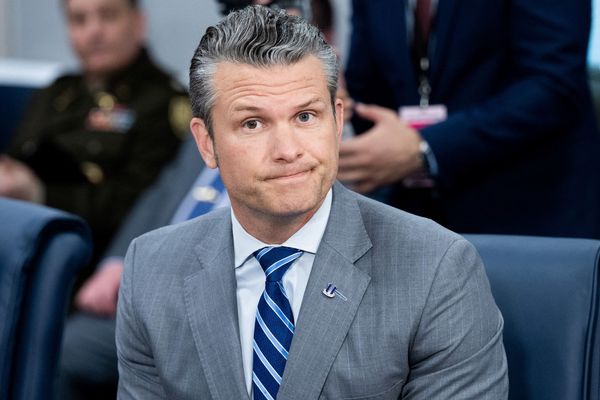It started with a panicked call to the ABC switchboard asking to speak to someone in the newsroom.
The desperate voice on the other end of the line was begging for help.
That initial conversation was the first of dozens that followed a similar pattern — describing how a sex cult was allegedly harming vulnerable young women and despairing that authorities seemed unable or unwilling to intervene.
Weeks later, producer Kyle Taylor and I found ourselves at a dodgy regional New South Wales pub being heckled by the locals who had no idea what was going on as we frantically photographed hundreds of pages of tattered "slave journal" entries.
They were brought to us in a black bum bag by a woman who alleged she was enslaved, forced into sex work, abused, coerced and threatened by a man she was forced to call her "Master".
This is how a five-month investigation by ABC Investigations and Four Corners into former Australian army soldier James Davis and his acolytes, the so-called 'House of Cadifor', began.
It ended with a dramatic police raid after Four Corners provided information to the Australian Federal Police.
Davis was arrested in the car park of the local hardware store by plain-clothed AFP officers and charged with sexual slavery offences.
The journals belonged to Felicity Bourke, Davis's former partner of three years.
Her bravery in speaking out and trusting us with her story is what dozens of women and the families of those still living with Davis had been waiting for.
We spoke with Felicity many times and met with her on three occasions, each over several days, before we filmed a sit-down TV interview.
We spoke to her family, friends and her social worker.
We connected her with lawyers and offered counselling.
Eventually, we would pass her details, with her permission, on to the Australian Federal Police.
Her testimony is what finally led to Davis being charged.
For months, we had agonised over how to investigate and navigate such a complex and traumatic story.
We spent many hours on the phone and in person, meeting and hearing the stories of dozens of women and several men who had known Davis and his associates over the years.
As we continued our research, we came to believe that Davis was using classic cult tactics to indoctrinate the women who followed him.
A complex and challenging story
We found ourselves surrounded by a fog of trauma, stories of horrendous sexual abuse, rape and violence allegedly perpetrated by a number of different men.
Complicating the situation was that many of the alleged incidents they described had occurred within the context of BDSM relationships, which sometimes involved consensual violence.
"There's a clear line between BDSM and abuse and that line is consent," one woman told us.
But we soon realised that the line between consenting and not consenting had been blurred by power imbalances, peer pressure and coercion, as well as by drugs and alcohol.
Some of the women we spoke to had signed contracts consenting to particular sex or violent acts or had agreed in writing to become submissives or slaves to men.
They felt trapped, ashamed and like they couldn't say no because they believed they had signed away their rights.
That was just one reason they'd never come forward about their treatment.
Many were also sex workers with a profound mistrust of law enforcement.
We were faced with people who had complex histories of trauma and who were themselves still coming to terms with difficult questions around what had happened to them, often when they were still quite young.
Had they consented?
Were they able to?
Was it an abuse of power?
What would it mean for them if they were assaulted?
We later learned that there is no such thing as consent to certain offences such as slavery and trafficking.
They recalled in graphic detail what had happened to them.
Sometimes once they started speaking it was hard to interrupt or get them to stop.
They held back little, disclosing the most explicit and violent details.
Few wanted to be interviewed formally or go on the record but every person we spoke to helped us open up a dark and murky world that was difficult to comprehend.
What we uncovered was a BDSM sex cult allegedly targeting vulnerable young women and coercing them into participating in increasingly violent sexual situations, sometimes filmed and sold for profit.
Some of the women went to group sex parties where they were blindfolded, numbered and given drugs and alcohol.
Others participated in elaborate ceremonies and signed contracts of enslavement to men, they wore slave collars and were controlled by men who allegedly instructed them to have sex with others for money.
A traumatic story takes its toll
In the months we spent working on the story, we were sent photos and videos of women being physically assaulted, screaming and crying in pain.
They were sometimes tied, bound and gagged, unable to escape.
This kind of horrific material would be delivered in emails and texts at all hours of the day and night.
There was call after call from women recounting in graphic detail horrendous sexual assaults perpetrated by different men in the BDSM community.
Some of these incidents were totally unconnected to the story we were focused on but word had gone around that there were journalists who were investigating and they wanted to help.
It felt selfish to cut the call short or react emotionally when I wasn't the one who had suffered.
Sometimes I hung up the phone and just cried in despair.
I could hear the pain in their voices and knew there was little I could do to help.
I lay awake worried about the impact of our work on the women we spoke to.
What if we made things worse?
How could we be sure that they were supported after they shared their traumatic experiences?
I wasn't a sexual assault counsellor. How was I supposed to respond correctly to what I was hearing?
There were guidelines for dealing with survivors of sexual abuse and domestic violence but in many situations, there seemed to be no rule book for exactly how to navigate the complexities involved in this kind of story.
I started seeing a specialist trauma psychologist early in the project when I realised I would need support to be able to keep working on such distressing subject matter.
Some days I felt like I was working in slow motion, reading the same sentence over and over again, unable to process it.
I was annoyed at myself for being weak, lazy and unproductive.
I now understand that was a natural reaction to being repeatedly exposed to traumatic material.
I noticed I would sometimes emotionlessly recount graphic details to shocked colleagues who enquired how the story was going.
I became keenly attuned to any perceived power imbalances or signs of abuse in society or social situations.
At times I felt as though I was viewing the world through a completely different and dark lens that few people could understand.
How could such horrendous things be happening with such apparent regularity?
How could the world be so bleak?
How could so many men do such horrendous things to women?
Through therapy, I can see that these are overgeneralisations and thought distortions, which can be a symptom of vicarious trauma.
Journalists need to take vicarious trauma seriously
Vicarious trauma can happen through indirect exposure to traumatic events and can manifest in a range of physical and psychological symptoms.
If not addressed, it can lead to ongoing PTSD and other mental health problems.
Journalists are regularly exposed to crime scenes, the aftermath of natural disasters, violence, raw emotions from grieving families and other traumatic situations.
Many of us have witnessed our colleagues suffer from trauma and PTSD related to their work.
Some have been so profoundly affected they've been unable to continue working.
I'm aware I am in the extremely fortunate position of being a journalist in a secure job with supportive bosses and colleagues.
I don't know how I would have coped without having access to a qualified professional to debrief.
When I started seeing a psychologist, the first thing I naively wanted to know was how I could just simply "not be traumatised" by what I was hearing and seeing.
The answer was that without dropping the story altogether, that wouldn't be possible.
Instead, I needed strategies to mitigate the trauma from my exposure.
The obvious and boring ones I deployed with mixed success were eating and sleeping well, exercising and not using alcohol as a coping strategy.
I worked on drawing boundaries around when I would answer calls and respond to texts and tried to clearly separate work and home time, although this wasn't always possible.
Kyle and I shared the load when it came to limiting our exposure to traumatic material.
There were things I found I simply could not watch or read.
Sometimes there seemed to be no rhyme or reason to what I would find triggering.
We tried to work on different content during set time periods with breaks in between.
There would be something wrong with us if we weren't moved and upset by what we were seeing.
What kept us going was the determination of the women who wanted to tell their stories.
Authorities often say that they are powerless to act in these matters without people being willing to come forward and to speak up.
When we set out to discover what was going on for this story we found something different.
We had to make sure we were ready and able to listen.
If you have more information contact the AFP on 131AFP (131 237) or email NOSSC-Client-Liaison@afp.gov.au
If you are a victim of trafficking or know someone who is contact the AFP on 131AFP (131237) or email NOSSC-Client-Liaison@afp.gov.au
You can also contact the Red Cross Support for Trafficked People Program on 03 9345 1800







